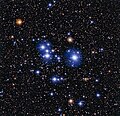astro.wikisort.org - Galaxy
Messier 47 (M47 or NGC 2422) is an open cluster in the mildly southern constellation of Puppis. It was discovered by Giovanni Batista Hodierna before 1654 and in his then keynote work re-discovered by Charles Messier on 1771.[lower-alpha 1] It was also independently discovered by Caroline Herschel.
| Messier 47 | |
|---|---|
 Open cluster Messier 47 in Puppis Credit: NOIRLab / NSF / AURA | |
| Observation data (J2000.0 epoch) | |
| Right ascension | 07h 36.6m [1] |
| Declination | −14° 30′[1] |
| Distance | 498 pc[1] |
| Apparent magnitude (V) | 4.4[2] |
| Apparent dimensions (V) | 30′[2] |
| Physical characteristics | |
| Mass | 453[1] M☉ |
| Radius | 10.61 pc[1] |
| Estimated age | 78 million years |
| Other designations | NGC 2422, Cr 152 |
There is no cluster in the position indicated by Messier, which he expressed in terms of its right ascension and declination with respect to the star 2 Puppis. However, if the signs (+ and −) he wrote are swapped, the position matches.[3] Until this equivalency was found, M47 was considered a lost Messier Object. This identification as the same thing (ad idem) only came in 1959 with a realization by Canadian astronomer T. F. Morris.[4]
M47 is centered about 1,600 light-years away and is about 78 million years old. The member stars have been measured down to about red dwarfs at apparent magnitude 19. There are around 500 members,[1] the brightest being HD 60855, a magnitude 5.7 Be star. The cluster is dominated by hot class B main sequence and giant stars, but a noticeable colour contrast comes from its brightest red giants.[4]
It about a degree from Messier 46, which is much older and much further away.[4]
Gallery
- Image of star cluster Messier 47 taken using the Wide Field Imager camera, installed on the MPG/ESO 2.2-metre telescope at ESO’s La Silla Observatory in Chile.
See also
- List of Messier objects
References and footnotes
- Prisinzano, L; Micela, G; Sciortino, S; Favata, F (2003). "Luminosity and Mass Function of the Galactic open cluster NGC 2422". Astronomy & Astrophysics. 404 (3): 927–938. arXiv:astro-ph/0304321. Bibcode:2003A&A...404..927P. doi:10.1051/0004-6361:20030524.
- Stoyan, Ronald (2008). Atlas of the Messier Objects: Highlights of the Deep Sky. Cambridge University Press. p. 195. ISBN 978-0521895545.
- Houston, Walter Scott (2005). Deep-Sky Wonders. Sky Publishing Corporation. ISBN 978-1-931559-23-2.
- "The hot blue stars of messier 47". ScienceDaily. 17 December 2014.
- on February 19
External links
 Media related to Messier 47 at Wikimedia Commons
Media related to Messier 47 at Wikimedia Commons- Messier 47, SEDS Messier pages
- Messier 47 Amateur Image - Waid Observatory
- Messier 47 on WikiSky: DSS2, SDSS, GALEX, IRAS, Hydrogen α, X-Ray, Astrophoto, Sky Map, Articles and images
На других языках
[de] Messier 47
Messier 47 (auch als NGC 2422 = NGC 2478 bezeichnet) ist ein 4,4 mag heller offener Sternhaufen mit einer Winkelausdehnung von 30' im Sternbild Puppis. Der Haufen ist ungefähr 1600 Lichtjahre entfernt und seine 50 Sterne erstrecken sich über ein Gebiet von etwa 10 Lichtjahren. M47 ist rund 80 Millionen Jahre alt.- [en] Messier 47
[es] Cúmulo abierto M47
Messier 47 (también conocido como M47 o NGC 2422) es un cúmulo abierto en la constelación Puppis. Fue descubierto por Giovanni Batista Hodierna antes de 1654 e independientemente descubierto por Charles Messier el 19 de febrero de 1771.[ru] M 47 (звёздное скопление)
Рассеянное скопление M 47 (также известное как Объект Мессье 47 или NGC 2422) является рассеянным скоплением в созвездии Кормы.Другой контент может иметь иную лицензию. Перед использованием материалов сайта WikiSort.org внимательно изучите правила лицензирования конкретных элементов наполнения сайта.
WikiSort.org - проект по пересортировке и дополнению контента Википедии

